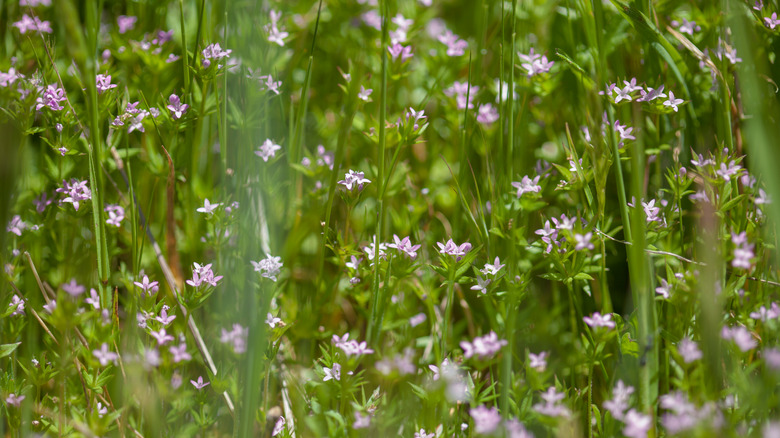The Kitchen Staple That'll Prevent Field Madder From Wreaking Havoc In Your Yard
We may receive a commission on purchases made from links.
The botanical intruder that is field madder, scientifically dubbed as Sherardia arvensis, could easily be mistaken for a quaint addition to your yard with its petite lavender to pale pink flowers that emerge between mid-winter and mid-summer. Often, it's confused with its botanical cousin, catchweed bedstraw. However, don't let the looks of this low-growing green invader deceive you. You're facing a green adversary that propagates via seeds and is capable of creating mats that could transform your garden into a botanical warzone. So, how do you eliminate field madder before it takes over your yard? In this contest for supremacy, choose to eschew the usual synthetic herbicides. Nestled within your home is a kitchen staple that's remarkably effective against pesky weeds — enter vinegar.
The prowess of vinegar against the likes of field madder lies in its acetic acid, which engages in a relentless assault on contact. Acetic acid eradicates weeds by rupturing their cell walls, causing vital fluids to leak and, ultimately, leading to dehydration and death. Beyond the effectiveness, this battle against field madder aligns perfectly with the surging demand for weed-busting solutions devoid of harmful chemicals. In addition, it doesn't come at a steep price — for example, a gallon of Natural Elements 30% Vinegar on Amazon will set you back only $21.99. But remember, acetic acid works best with younger weeds.
How to get rid of field madder with vinegar spray
Kick off your assault by arming yourself with vinegar and dish soap. Here's the kicker, though — cooking vinegar won't cut it. You need herbicidal vinegar with an acetic acid concentration of 20% or more. Think of dish soap as your covert ops agent — a surfactant that breaks down the surface tension on the leaves so the vinegar can penetrate and dry up the cells. However, the vinegar's indiscriminate nature means it will spare nothing green in its path. Physical barriers like plastic tarps and cardboard will suffice to protect desirable plants.
The potential of vinegar to cause harm isn't limited to the plants alone. Once you enter the 20% acetic acid territory, you sign up for nasty chemical burns. So, wear protective gear, including gloves, long sleeves and pants, and safety glasses. Remember, the infestation intensity dictates your weed-busting mixture's volume (a gallon of vinegar goes with a tablespoon of dish soap). Mix the ingredients in a spray bottle (leaving just enough space to give it a good shake) and spray the solution directly onto the weeds.
Your grass might suffer as much as the weeds in your lawn. As a result, you may want to consider the alternative strategy of hand-pulling the field madder or painting their leaves with a vinegar-drenched paintbrush. Two to three days later, survey the treated area for field madders with wilted and browning leaves — pull up the dead weeds by their roots and discard them in trash bags.
Caveats for killing field madder with vinegar
Horticultural vinegar won't neutralize field madder seeds, which could be poised to sprout anew. The assault must, therefore, commence before field madder weeds bloom. Adding a tactical twist, a tablespoon of salt can be added for a concoction that ruthlessly dehydrates the cellular structures of those unwanted guests. The day might be fine, but a wayward breeze can turn traitor in no time, dispersing the acidic droplets beyond the intended targets and threatening the well-being of neighboring plant life.
Despite the risk of collateral damage, the vinegar's efficacy is exponentially enhanced on a bright, sunny day when the weeds are actively photosynthesizing and their pores (stomata) are readily open. However, the forecast of rain can quickly undermine the alliance between the sun and vinegar. A sudden shower can wash away your efforts like drawings in the sand, leaving the field madder unscathed and ready to rise again. Maintaining a keen eye on the weather will prevent futility.
If the green invaders dare to show signs of life post-spraying, reapply the vinegar spray. However, exercise caution, for frequent inhalation of concentrated acetic acid vapor can adversely affect your respiratory system and teeth. Biweekly reapplication is considered safe. Field madder in your lawn? Timely mowing will suffice to thwart the weed's flowering and seed production. Complement this with a broader fortification strategy for strengthening your lawn's resilience — think core aeration, diligent fertilization, and vigilant watering.


